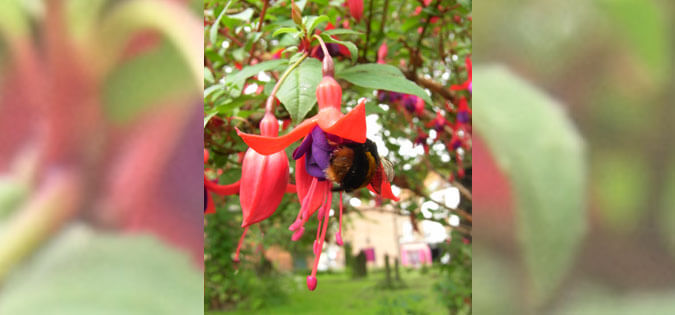By Margaret Silf
From Inner Compass

Ignatius urges us to seek the freedom of detachment or indifference. Neither of these words carries weight in today’s language or culture. Both sound cold and uncaring, which is far from the spirit in which Ignatius used them. A better word might be balance.
In his First Principle and Foundation, Ignatius talks about “making use of those things that help to bring us closer to God and leaving aside those things that don’t.”
At first this notion seemed rather exploitative to me, as if the whole of creation were only there for us to select from it the bits that seem to serve our purpose. It didn’t come to life for me until one day when I was sitting on a bench in a quiet, sunny courtyard, looking at a fuchsia bush. It was late August, and the bees were constantly visiting the fuchsia. They would land very gently on those flowers that were fully open to receive them. They made no attempt to enter a closed flower or to force the petals in any way. When they found an open flower they crept into its depths to extract the nectar. In doing so, of course, they also carried the pollen from flower to flower, bush to bush, thus ensuring further fruitfulness.
As I watched them, I realized that although the bees were choosing the fuchsia flowers and disregarding other plants growing in the courtyard, other insects were seeking their nourishment from different sources. In choosing what was exactly right for them, they were not only receiving their own nourishment but were also playing an essential role in the fruitfulness of their environment. And in choosing one plant rather than another, they were in no way rejecting or denigrating the others. The secret of this harmonious, cooperative life seemed to lie in each creature’s being true to its own essential nature. Each gained what it needed for survival and growth from the source that was right for it, and it did so without harm either to itself or to the flowers. In fact, after each encounter, both insect and flower were left in a richer state than before: the insect had been nourished and the flower had been pollinated.
I found this picture to be a very vivid illustration of what it might mean to “make use of what leads to life” and to leave aside what, for each individual, does not lead to life. It was a truly creative kind of “detachment.” It helped me to understand what God might be calling us to when he asks us to let go of our attachments. The bees, I noticed, made no attempt to “possess” the flowers, nor did the flowers attempt to trap and hold the bees. This was a free interchange, perfectly fulfilling the needs of the bees, the fuchsia, and the wider circle of creation around them.
Excerpt from Inner Compass by Margaret Silf.
Image by blodgett esq. under Creative Commons license.
